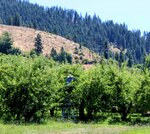

This is the second article in a series about the pear industry in Leavenworth. The first installment provided a brief origin story and general history of the tree fruit business in the Upper Wenatchee Valley. This second installment, thanks to the Leavenworth Public Library, the Greater Leavenworth Museum, and the Washington Historical Society, examines the two major waves of migration for work in the orchards amid the industry’s intensive growth in the middle decades of the 20th century.
LEAVENWORTH – Growing pears in Leavenworth began as a modest agricultural pursuit in the late 1800s. Soon, though, it blossomed into a thriving industry, drawing in not just the fruits of the land but also waves of immigrants who have left an indelible mark on the greater community. From the Dust Bowl refugees of the 1930s to the Mexican workers of more recent decades, the story of these immigrants is one of resilience, hard work, and the pursuit of a better life.
In the 1930s, the Great Depression and the Dust Bowl drove thousands of families from the Great Plains and Prairies to the fertile lands of California, as was popularized by John Steinbeck in his novel The Grapes of Wrath, and to the Pacific Northwest. Among these were the “Okies” from Oklahoma and the "Arkies" from Arkansas. North Central Washington (NCW), with its burgeoning fruit industry, offered a glimmer of hope for these destitute families.
The journey to NCW was arduous, with many traveling in overcrowded vehicles and living in makeshift camps along the way. Upon arrival, they faced a mixed reception. While there was a demand for labor in the orchards, the newcomers often encountered hostility from locals who viewed them as competition for livelihoods.
Despite these challenges, the Okies and Arkies proved to be hardworking and hardy.
As the Wenatchee World’s longtime publisher, Wilfred Woods, recalled (in a 2008 interview published in Gregory D. Hinze’s 2010 paper Take Hold: The Arkansas Migration to North Central Washington):
Well, of course, these were the days when everything was picked in apple boxes, handled by hand. The warehousing required a lot of people because they were stacked boxes. There was nothing mechanical about it. They were loaded onto the freight cars by hand and stacked into the refrigerated freight cars. Everything was done by hand. The refrigerated cars were loaded with ice by hand.
Their efforts were crucial in sustaining and expanding the orchard industry in Leavenworth and greater NCW during those economically fragile years.
The post-World War II era saw significant changes in the agricultural labor force in Leavenworth. As the demand for fruit continued to grow, so did the need for reliable and efficient labor. The Bracero Program (from the Spanish term bracero, meaning “manual laborer”), a U.S. government-initiated program in 1942 and lasting until 1964, brought millions of Mexican workers to the United States, including Leavenworth, under temporary work contracts.
These Mexican laborers, known as “braceros,” played a vital role in the industry. They were often tasked with the most grueling jobs, such as thinning and picking the fruit. Despite facing harsh working conditions, low wages, and inadequate housing, the braceros’ contributions were indispensable.
After the Bracero Program ended, many Mexican workers chose to stay in the United States, becoming permanent residents and establishing roots in the region. They were soon joined by new waves of immigrants from Mexico and Central America, who sought better economic opportunities for their families. Today, roughly one-third of Chelan County residents are Hispanic.
The immigrant experience in Leavenworth and NCW orchards has been marked by both challenges and contributions. Language barriers, cultural differences, and legal hurdles have often made life difficult for immigrant workers. Many have faced exploitation and discrimination, struggling to secure fair wages and safe working conditions.
Despite these obstacles, many immigrant workers have not only made significant contributions to the orchard industry and the local economy, they have thrived. As NCW-owning orchardist Enrique Betancourt-Gonzalez straightforwardly put it: “The pear industry brought my family here, and it has supported us, and been very good to us. Just like many other migrant families.”
Immigrant labor, management, and ownership in the orchards has been essential in maintaining the region’s status as one of the leading fruit producers in the United States. And the cultural diversity brought by these immigrant communities – cuisine, festivals, music, dance, language, social structure - has enriched the local social fabric.
The story of immigrant workers in North Central Washington orchards is ongoing. As the agricultural industry in Leavenworth faces new challenges, including climate change and global market fluctuations, the contributions of immigrant workers remain as vital as ever.
Caroline Menna is an intern for Ward Media and a rising senior (Class of 2025) at Cascade High School. She will serve as Editor-in-Chief of the Cascade High School Publications Group for the 2024-2025 academic year.
Comments
No comments on this item Please log in to comment by clicking here